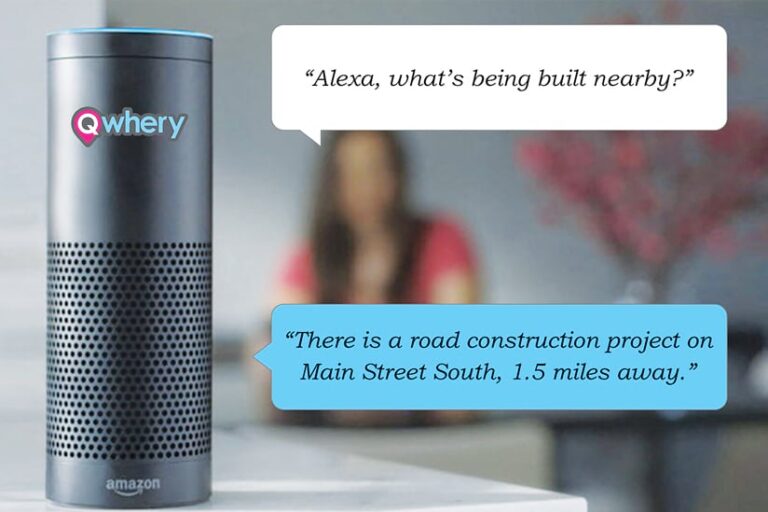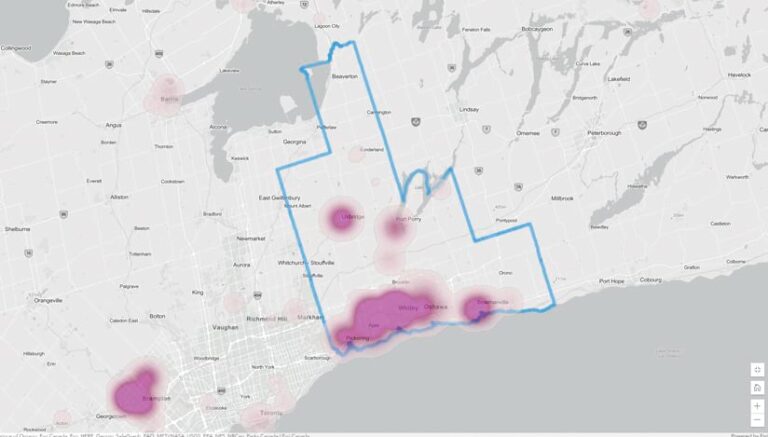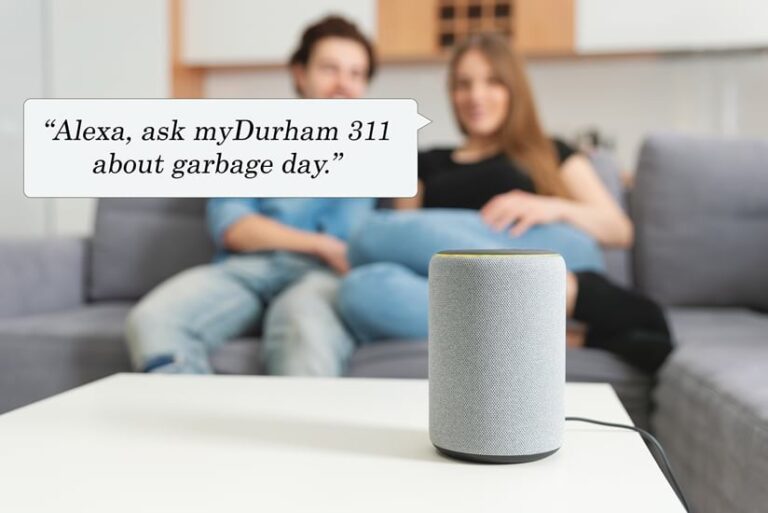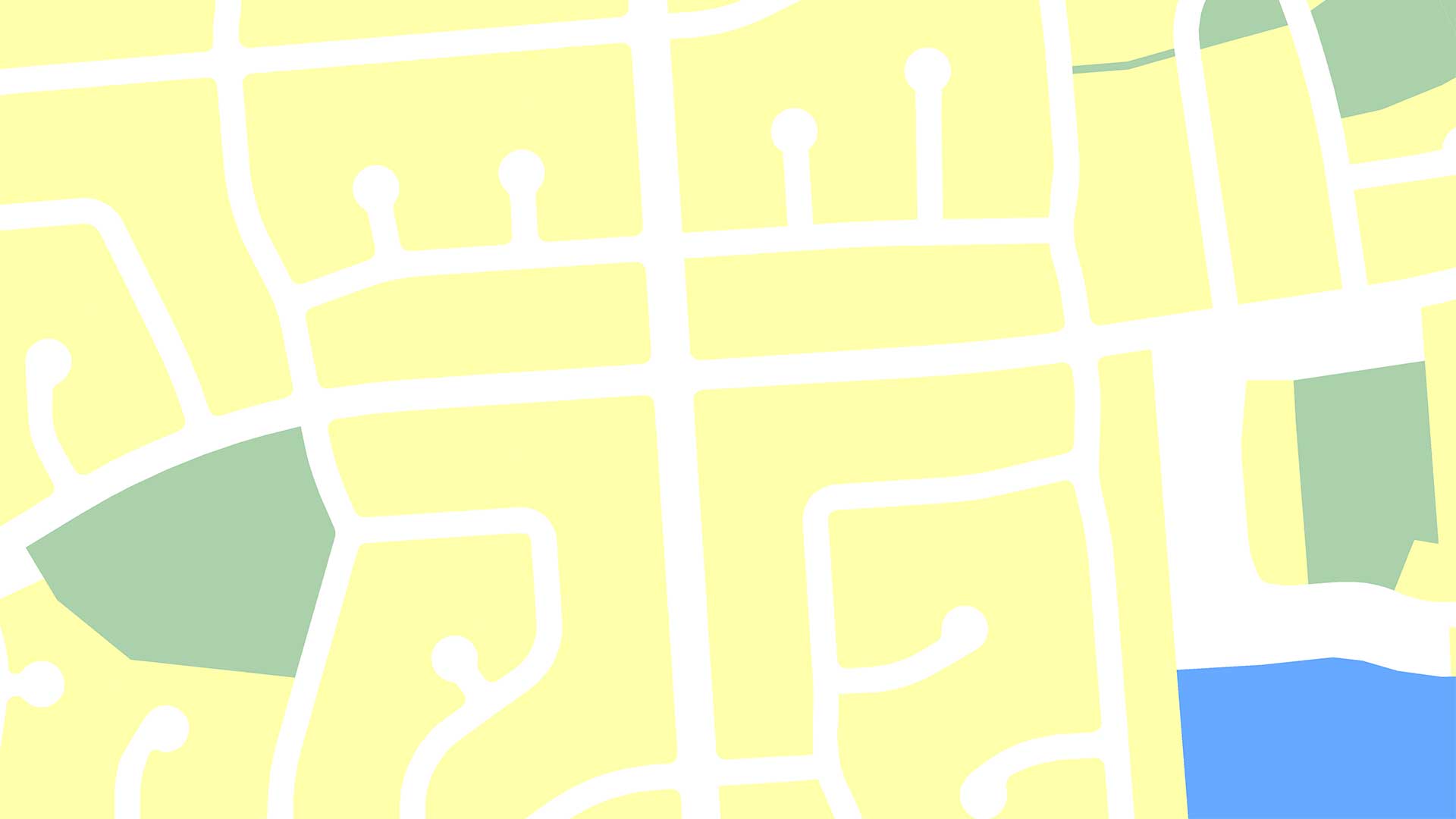Canada’s Durham, Ontario, region is home to several of the fastest-growing technology organizations in the nation. This atmosphere of technological innovation is reflected in the government’s commitment to improving the lives of residents by making information more widely available. Known as Durham Region, the government organization has a new smart city strategy that focuses on creating an omnichannel approach to communication.

Early in 2021, Durham Region partnered with two organizations—the Spark Centre, which provides resources to entrepreneurs, and the Ontario Centre of Innovation, which fosters collaboration between academia and industry—to challenge small- and medium-sized enterprises to help make regional services more accessible to the public. In response, Esri startup partner and voice technology company Qwhery, Inc., developed myDurham 311, a tool that integrates with ArcGIS technology and is designed to help users access regional information through smart home devices.
Connecting Homebound Residents with Crucial Information
Content and services on municipal websites can be difficult to find, and residents who use a city’s call center to get specific information often get frustrated by long wait times. Compounding the problem, many cities faced budget cuts due to the COVID-19 pandemic—a time when local government organizations needed to engage with residents often yet had to move more of their services online.
Municipalities such as Durham are finding it increasingly difficult to meet their target service levels year after year and are actively seeking innovative communication channels to use to connect with residents. Smart home devices and virtual assistants offer an intuitive way to link people with the local information and services they need.
Durham’s challenge posed the question, How can Durham Region leverage smart home technologies and 5G to empower residents to interact with regional services? Qwhery’s existing integration with ArcGIS Solutions and ArcGIS APIs, paired with its own platform’s ability to consume spatial data from local municipalities’ open data portals, made the company an ideal candidate to respond to the call.
Qwhery provided a solution that connects many municipal business systems on one platform that reaches approximately 800,000 users in and around Durham.

A Startup Company Built from Open Data
Qwhery has been an Esri startup partner since 2020. Cofounder and CEO Matt Pietryszyn has been an advocate of municipal government transparency and community engagement for almost 20 years.
In 2019, Qwhery was founded as a voice-first solution provider that helps cities connect their open data to voice-enabled devices like Amazon Alexa and Google Assistant. This allows residents to ask their smart speakers the same questions they would use a call center for, but without the wait times.
Qwhery already had a history of creating innovative solutions for local governments before Durham Region put out its call for development. Relying on its existing use of ArcGIS REST APIs and ArcGIS Solutions, Qwhery built a service in 2020 called Where to Vote in Collin County, Texas, for Amazon Alexa and Google Assistant. Leveraging the location of each user’s device, the solution queried Collin County’s existing feature services to help more than 200 voters find their nearest polling place while also providing directions for how to get there and current wait times. This got people to their voting locations safely and efficiently, helped them avoid large crowds, and contributed to a record-breaking turnout for the 2020 United States presidential election.
Other custom-branded solutions from Qwhery include Marketplace Milton, a voice-enabled business directory for Milton, Ontario, Canada, and Ask Sugar Land, which connects the City of Sugar Land, Texas’s mature and well-established enterprise GIS to voice technology. The solution provides immediate responses to community members’ questions through apps and devices that Sugar Land residents were already using, which increased adoption rates and improved citizen engagement. These implementations gave Durham Region reason to trust Qwhery’s ability to deliver.
A Voice-Enabled Solution That Residents Can Use Anywhere, Anytime
With myDurham 311, residents of Durham can easily find out information about elected officials and regional facilities, when waste pickup happens in their neighborhoods, where the nearest bus stop is, and even when to expect the next Durham Region Transit bus. To enable the voice service, all users have to do is say, “Alexa, open myDurham 311,” or “Hey, Google, talk to myDurham 311,” to their respective devices. The service then guides users through how to interact in a conversational way with Durham Region information.
“Durham Region is a forward-thinking organization, focused on innovation and modernization,” said Elaine Baxter-Trahair, chief administrative officer for Durham Region. “This service is the first step in our transformation toward a customer-centric approach.”

myDurham 311 showcases how Durham Region is focused on improving the customer experience through an omnichannel approach. It is a coordinated system that helps ensure that regional services are accessible in a variety of ways, including in person; via the web, emails, and phone calls; and on social media. As the product matures, further capabilities will be introduced to myDurham 311—especially as Durham Region integrates more systems into the voice solution. This will make it easier for residents to quickly access the information that’s most relevant to them based on their location and where certain services are available.
This ability for residents to interact quickly with government services will eventually produce cost savings for Durham Region’s call center. Currently, municipalities the size of Durham spend approximately C$6 (US$4.70) per call and answer between 300,000 and 500,000 phone calls from residents per year. Providing more information to residents through a voice-enabled, location-based platform will also allow call center staff more time to address more complicated questions. This should increase customer satisfaction in the short and long terms.
Having a voice service on two of the largest smart home device platforms that integrates with its own location-based data is making Durham Region one of the first municipalities to provide residents with key local information wherever they are, whenever they need it. As Baxter-Trahair pointed out, “True customer engagement begins by offering access to services at a time that works for the individual rather than the corporation.”
Municipalities currently using ArcGIS software, including ArcGIS Online, can easily connect their data and services to the Qwhery Cloud and begin engaging with residents and customers through new and modern communication channels. For more information about Qwhery’s voice-enabled solutions, contact Pietryszyn at matt@qwhery.com.

